History of Choir Robes
History of Choir Robes
Origin information of choir gowns, church vestments, choral uniforms and outfits.
We've received numerous requests for information on the history of choir robes.
A complete account of the origin and background history of choir gowns is beyond our research ability. However, this article offers a brief chronicle of the record of events from the past concerning the costumes and dress used in mostly religious and school institutions for choirs. Based on known documentation from that era, we attempt to report a chronology and timeline of those outfits known as choir robes.
Before delving into the far past, it's useful to keep in mind where we are now with choir robes. The modern religious and choral robe currently empolys different robes, gowns, and vestments for different individuals and groups within the school, church, temple, or other religious or secular institution.
The Choir: In addition to the choir gowns for choir members, there is a directors robe and organists robe for specific members of the choir. Sometimes a bell choir will have their own type of choral gowns. For a children’s choral group you often find acolyte robes. Churches with multiple choirs will often have different choral vestments or choral uniforms for each choir.
The Sanctuary: Outside the choir for services, the types of church robes often include a robe for the lead speaker. Depending on the institution, this may be a minister robe, pulpit gown, church vestments, rabbinical gown, or doctoral robe. Finally, various specific religions and groups use clerical vestments for members of the clergy.
Specific Events: Certain specific events also require special church robes, such as baptismal robes for a baptism.
Schools and Choral Organizations: A variety of different styles are used for schools, amateur singing groups, and professional chorus or choral organizations (often along with a symphony or other musical accompaniment).
Origin of the Choir Robe - Timeline
Ancient Egypt
The earliest visual depiction of a group of singers performing can be found in ancient tombs in Egypt around 2700 BC. However, there was no indication of a robe, vestment, or other formal or organized clothing for such early choirs. The image to the right depicts what is believed to be a blind choir of ancient egypt. |
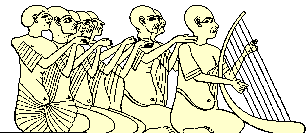 |
Ancient Greece and Rome
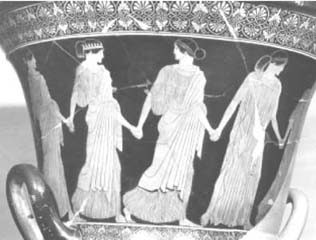 |
The earliest evidence of a potentially-formal choir robe is found in ancient Greece. The Greek Chorus seems to have been relatively common in that era, and can be seen depicted on a portion of pottery dating from around 425 BC. That Greek pottery displays members of a choir both singing and playing musical instruments. The members of that ancient choir are seen wearing lengthy loose gowns that reach up and across their left shoulders. Those pictured in the pottery displayed to the left obviously have a slighlty more elaborate design than the earliest depiction. The use of gowns likely developed from the ancient tunic. Indeed, clerical vestments such as an alb are directly related to the ancient tunic, with the word origin being a latin phrase meaning a tunic of white. Modern albs remain a plain, lightweight, ankle-length tunic with long sleeves, with a rope cincture about the waist. Ancient tunics were sleeveless, and were seen as a distinction from barbarians wore sleeved clothing (probably because those tribes lived in the colder regions). The tunic eventually did include a sleeve around the 3rd century, after military leaders returned from a campaign wearing them. This combination of tunic and choir evolved with time. |
Early Judaism
The Jewish Torah (bible) provides some possible indications that choirs held a role for the early Hebrews. For example, Nehemiah Chapter 12, section 31 has the leaders of Judah assigning two choirs to offer thanks in some translations of that section. Jewish law dictates vestments or robes for the high priest and for certain other roles at this time as well. However, I have yet to find evidence that these choirs wore robes. Pictured to the right is a high priest of this era, in complete regalia. |
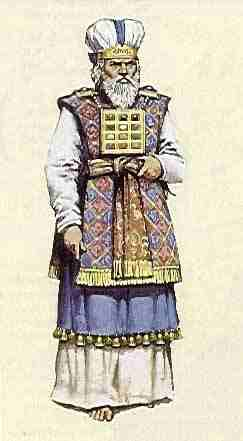 |
Early Christianity
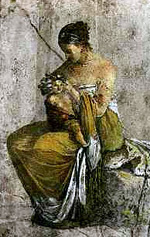 |
The first four centuries of Christianity did not
involve a special robe, tunic, vestment or other garb for members
of the clergy nor presumably and choirs used in a religious setting
or otherwise. Tunics remained the primary article of clothing,
typically knee-length to ankle-length, usually with a cincture.
Often, and additional article of clothing known as a himation
was worn. This was rectangular, and wrapped around ones body over
the tunic. Himations came in various colors, qualities, and designs
dependant on occupation, gender, and status. There is no evidence
that the himiation became a clerical vestment. |
Medieval Era
| Until this time, music notations for choirs typically
used only small notes sketched above words indicating the fall or
rise of voice, but not duration or note pitch. Choir music evolved
in this era to include the Gregorian chant, named after Pope Gregory
I. He also mandated music standardization, including rules for composers
and musicians for performing and writing music. Boys choirs also began to rise in prominence at this time. Because many of the better schools were associated with the Church, they also trained boys for choirs. Examples include the “Ratisbonne Choir”, started in Germany near the end of the tenth century, and “Kings College Choir” in England. Eventually, all major churches of the era included choristers. Choir fashions followed the fashion trends of clergy. With the rise of the surplice (white, sleeved, blouse-like shirt with lace trim worn over a cassock) worn over a cassock (plain black, long-sleeved, ankle-length tunic) as the official clergy garment, choirs also adopted this style. Uniformity and a formalization of a “choir look” came about. |
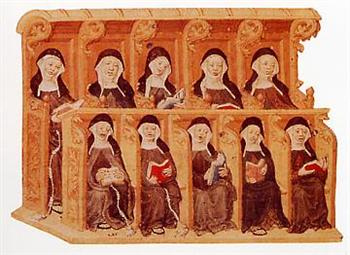 |
Renaissance
 |
Secular choirs started to gain influence once wealthy patrons started sponsoring musicians in the Renaissance period. The oldest written evidence of polyphonic choral singing dates from the late 1300s to around 1420 with the Old Hall Manuscript (pictured to the left). This document uses divisi (two or more voices per part). |
Sacred choral music rose to prominence as the foremost
formal music in Europe. During the era, music composition produced
hundreds of motets and masses for primarily a cappella choirs.
Choral music composed during this era remains desirable even today. Like the Medieval period, the trend in choir apparel followed
the fashion trends of the day. While a separate look was established
for the choir, uniformity in color and design was not required. |
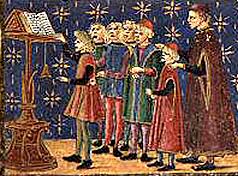 |
Reformation
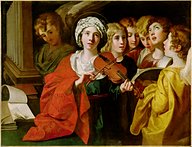 |
A new style of pulpit wear took hold during the Reformation era,
called the Geneva style. This style, still in use today, was based
on Academic Regalia for doctoral graduates. Choirs of the reformation
followed suit, adopting gowns based on the graduation robe style
rather than the secular fashion of the day. It is at this time that
the four basic types of gowns were established which remain today:
clergy robes, choir gowns, academic robes, and judicial robes. The baroque period of music, with instrumentals, opera, and chords, flourished at this time and influence choral music. New harmonic techniques such as the counterpoint were developed, resulting in accompaniment for choirs by different ensembles in addition to the traditional a cappella choirs. Verse anthems alternated choral sections with accompanied solos. |
| Grand motets also separated sections into movements, while oratorios expanded on this work to form concert-length performance based on bible stories. Chorales hymns were also turned into cantatas with instrumental accompaniment by principally Lutheran composers at this time. |
Classical and Romantic Period
The 18th century focused on expanding use of the symphony and instrumental music. By the 19th century, sacred music left the religious context and secular stage concert productions for choirs became popular. Oratorios were still composed during this era as well, as were secular cantatas. Famous choral works of the time include Beethoven's Missa solemnis, Berlioz's Te Deum, Brahms' Ein deutsches Requiem, Rossini's Stabat mater, Schubert's masses, Verdi's Requiem, Berlioz's L'Enfance du Christ and Mendelssohn's Elijah.
|
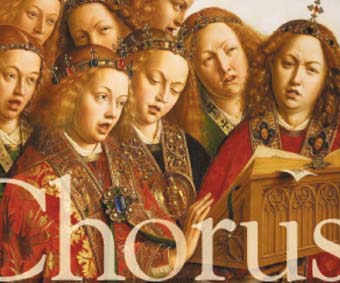 |
20th and 21st centuries
| Music for choirs evolved in the 20th century, which has become
a period of experimentation, formalization, and development. With
this evolution came the mass marketing of the choir robe for both
secular choirs in primarily schools, and religious choirs in churches
and temples. Choir robe sales started with a focus on just a few colors, styles, and fabrics. Originally, most choir gowns came in only one of three colors: black, white, and blue. With the advent of the popularity of gospel choirs the choir robe began to blossom into a multitude of choices. Now, choirs across the world can choose from over a hundred styles, with almost any color in the spectrum and numerous fabric choices and accessories. |
Additional Definitions and Notes
CHORUS: An ensemble performing the non-solo portion of a musical theatre production or opera or oratorio is generally called a chorus or chorale. Some other common names used for types of choirs include: Chamber choir, concert choir, show choir, opera choir, church choir, gospel choir, and male choir.
ROBES VS. VESTMENTS: Robes are not technically vestments. Robes are a
gown of up to ankle-length, with typically long sleeves, and designed
to be worn with no cincture. Four types of robes exist which evolved from
academic regalia worn by university faculty in medieval colleges: choir
gowns, academic robes, clergy robes, and judicial robes. All four types
of robes are intended to be worn over ones clothing. A stole can be worn
over a robe.
While vestments are worn by lay leaders, robes are not. The robe's original
intent was to designate that the person had academic credentials. Starting
with John Calvin, academic robes were worn in religious institutions and
churches. To this day, clerical robes are typically worn in churches of
the Reformed tradition, including Presbyterians, Calvinists, and Baptists.
| Return to Academic's main CHOIR ROBES page. | Return to Academic's HOMPAGE at choir robes |
| Request Gown Catalog . | Download a Robe Order Form. |
| View our selection of Choir Stoles and choral accessories. | View our History of Graduations page. |


